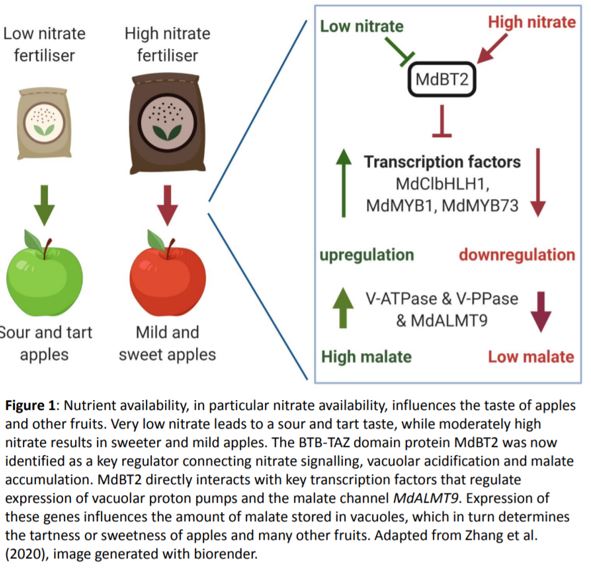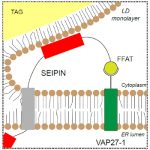Sweet or Sour? Important Link between Nitrate Signalling and Malate Accumulation Identified in Apple
Author: Stefanie Wege
ORCID: 0000-0002-7232-5889
Affiliation: ARC Centre of Excellence in Plant Energy Biology, Plant Research Centre,
School of Agriculture, Food and Wine, Waite Research Institute, University of Adelaide, Waite Campus, Glen Osmond 5064, South Australia, Australia
The organic compound malate has a large impact on the taste of many of our most popular fruits, for example grapes, tomatoes and in particular apples. The amount of malate in apples determines how tart (sour) or how sweet we perceive their taste. Taste preference is highly individual, with some people enjoying crisp and sour apples, while others prefer apples with a mild sweetness. In addition to taste, it was previously shown that malate accumulation and apple pigmentation share a connection, which explains why we associate bright green apples with tartness and deep red ones with sweetness (Figure 1) (Hu et al., 2016). Apple breeding has produced a large number of varieties, which generally produce either sweeter or tarter fruits (Xu et al., 2012; Etienne et al., 2013).
Apart from the variety, many environmental factors also affect malate accumulation. Therefore, colouration and taste within one variety can vary, and sometimes you bite into your favourite apple and it does not taste as expected. One of the factors influencing malate accumulation in fruits is nutrient availability (Etienne et al., 2013). In particular, high nitrate availability is known to affect fruit tartness (Spironello et al., 2004), but it was not known if there is a regulatory signalling mechanism connecting malate and nitrate accumulation, or if the two anions simply compete for storage space in the vacuole through independent signalling pathways (Figure 1).
 In this issue of Plant Physiology, Zhang et al. (2020) identified the key regulator protein MdBT2 (Malus domestica BTB-TAZ containing protein 2). MdBT2 provides a direct link between nitrate availability, vacuolar pH and malate accumulation. MdBT2 is a nitrate-responsive protein that physically interacts with an important transcription factor, MdClbHLH1. The MdClbHLH1 transcription factor regulates the expression of key genes involved in malate accumulation, such as the vacuolar proton pumps V-ATPase and V-PPase, and the vacuolar malate channel MdALMT9 (Figure 1) (Xu et al., 2012; Hu et al., 2016; Ma et al., 2019; Li et al., 2020).
In this issue of Plant Physiology, Zhang et al. (2020) identified the key regulator protein MdBT2 (Malus domestica BTB-TAZ containing protein 2). MdBT2 provides a direct link between nitrate availability, vacuolar pH and malate accumulation. MdBT2 is a nitrate-responsive protein that physically interacts with an important transcription factor, MdClbHLH1. The MdClbHLH1 transcription factor regulates the expression of key genes involved in malate accumulation, such as the vacuolar proton pumps V-ATPase and V-PPase, and the vacuolar malate channel MdALMT9 (Figure 1) (Xu et al., 2012; Hu et al., 2016; Ma et al., 2019; Li et al., 2020).
Under high/moderate nitrate, MdBT2 activity leads to the ubiquitination and degradation of MdClbHLH1, and ultimately to higher vacuolar pH and lower malate concentrations. Low nitrate or repression of MdBT2, on the other hand, lead to an increase in MdALMT9 and proton pump gene expression, increasing malate accumulation capacity. This response is nitrate specific, other inorganic anions such as chloride did not have the same effect (Zhang et al., 2020).
The novel molecular network identified by Zhang et al. (2020) provides a key insight on how nitrate signalling, vacuolar acidification and malate accumulation is regulated in plants. Additionally, the identification of a protein at the interconnection of nitrate sensing and malate accumulation provides a novel target for breeding strategies, not only in apple, but also in other crops, such as tomatoes, with the goal to optimise fruit quality and taste. Employing this new knowledge on the molecular mechanism, connecting nutrient supply and fruit taste, we might be able to ensure that we can enjoy or apples as tart or as sweet as each of us prefers.
Literature Cited
Etienne A, Génard M, Lobit P, Mbeguié-A-Mbéguié D, Bugaud C (2013) What controls fleshy fruit acidity? A review of malate and citrate accumulation in fruit cells. Journal of Experimental Botany 64: 1451-1469
Hu DG, Sun CH, Ma QJ, You CX, Cheng LL, Hao YJ (2016) MdMYB1 Regulates Anthocyanin and Malate Accumulation by Directly Facilitating Their Transport into Vacuoles in Apples. Plant Physiology 170: 1315-1330
Li C, Dougherty L, Coluccio AE, Meng D, El-Sharkawy I, Borejsza-Wysocka E, Liang D, Pineros MA, Xu K, Cheng L (2020) Apple ALMT9 Requires a Conserved C-Terminal Domain for Malate Transport Underlying Fruit Acidity. Plant Physiology 182: 992-1006
Ma BQ, Liao L, Fang T, Peng Q, Ogutu C, Zhou H, Ma FW, Han YP (2019) A Ma10 gene encoding P-type ATPase is involved in fruit organic acid accumulation in apple. Plant Biotechnology Journal 17: 674-686
Spironello A, Quaggio JA, Teixeira LAJ, Furlani PR, Sigrist JMM (2004) Pineapple yield and fruit quality effected by NPK fertilization in a tropical soil. Revista Brasileira de Fruticultura 26: 155-159
Xu KN, Wang AD, Brown S (2012) Genetic characterization of the Ma locus with pH and titratable acidity in apple. Molecular Breeding 30: 899-912



